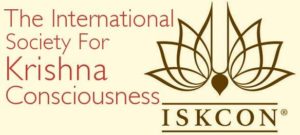The International Society for Krishna Consciousness (ISKCON), otherwise known as the Hare Krishna movement, includes five hundred major centers, temples and rural communities, nearly one hundred affiliated vegetarian restaurants, thousands of namahattas or local meeting groups, a wide variety of community projects, and millions of congregational members worldwide. Although just about fifty years on the global stage, ISKCON has expanded widely since it’s founding by His Divine Grace A. C. Bhaktivedanta Swami Prabhupāda in New York City in 1966.
ISKCON belongs to the Gaudiya-Vaishnava sampradāya, a monotheistic tradition within the Vedic or Hindu culture. Philosophically it is based on the Sanskrit texts Bhagavad-gītā and the Bhagavat Purana, or Srimad Bhagavatam. These are the historic texts of the devotional bhakti yoga tradition, which teaches that the ultimate goal for all living beings is to reawaken their love for God, or Lord Krishna, the “all-attractive one”.
God is known across the world by many names including Allah, Jehovah, Yahweh, Rama, etc. ISKCON devotees chant God’s names in the form of the maha-mantra, or the great prayer for deliverance: Hare Krishna, Hare Krishna, Krishna Krishna, Hare Hare / Hare Rama Hare Rama, Rama Rama, Hare Hare.
Many leading academics have highlighted ISKCON’s authenticity. Diana Eck, Professor of Comparative Religion and Indian Studies at Harvard University, describes the movement as “a tradition that commands a respected place in the religious life of humankind.” In the 1980s Dr. A. L. Basham, one of the world’s authorities on Indian history and culture, wrote of ISKCON that, “It arose out of next to nothing in less than twenty years and has become known all over the West. This, I feel, is a sign of the times and an important fact in the history of the Western world.”
ISKCON’s founder, Srila Prabhupada, has drawn appreciation from scholars and religious leaders alike for his remarkable achievement in presenting India’s Vaishnava spiritual culture in a relevant manner to contemporary Western and worldwide audiences.
Members of ISKCON practice bhakti-yoga in their homes and also worship in temples. They also promote bhakti-yoga, or Krishna Consciousness, through festivals, the performing arts, yoga seminars, public chanting, and the distribution of the society’s literatures. ISKCON members have also opened hospitals, schools, colleges, eco-villages, free food distribution projects, and other institutions as a practical application of the path of devotional yoga.
ISKCON devotees follow a disciplic line of Gaudiya Bhagavata Vaishnavas and are the largest branch of Gaudiya Vaishnavism. Vaishnavism means ‘worship of Vishnu’, and Gauḍa refers to the area where this particular branch of Vaishnavism originated, in the Gauda region of West Bengal. Gaudiya Vaishnavism has had a following in India, especially West Bengal and Odisha or Orissa, for the past five hundred years. Bhaktivedanta Swami disseminated Gaudiya Vaishnava Theology in the Western world through extensive writings and translations, including the Bhagavad Gita, Srimad Bhagavatam (Bhagavata Purana), Chaitanya Charitamrita, and other scriptures. These works are now available in more than seventy languages and serve as the canon of ISKCON.
Krishna is described as the source of all the avatars of God. Thus ISKCON devotees worship Krishna as the highest form of God, svayam bhagavan, and often refer to Him as “the Supreme Personality of Godhead” in writing, which was a phrase coined by Prabhupada in his books on the subject. To devotees, Radha represents Krishna’s divine female counterpart, the original spiritual potency, and the embodiment of divine love. The individual soul is an eternal personal identity, which does not ultimately merge into any formless light or void as suggested by the monistic (Advaita) schools of Hinduism. Prabhupada most frequently offers Sanatana-dharma and Varnashrama dharma as more accurate names for the religious system that accepts Vedic authority. It is a monotheistic tradition, which has its roots in the theistic Vedanta traditions.
Hare Krishna mantra
The popular nickname of “Hare Krishnas” for devotees of this movement comes from the mantra that devotees sing aloud (kirtan) or chant quietly (japa) on tulsi mala. This mantra, known also as the Maha Mantra, contains the names of God Krishna and Rama.
The Maha Mantra:
Hare Krishna Hare Krishna
Krishna Krishna Hare Hare
Hare Rama Hare Rama
Rama Rama Hare Hare
Seven purposes of ISKCON:
- To systematically propagate spiritual knowledge to society at large and to educate all people in the techniques of spiritual life in order to check the imbalance of values in life and to achieve real unity and peace in the world.
- To propagate a consciousness of Krishna, as it is revealed in theBhagavad-gita and the Srimad-Bhagavatam. The principle of reincarnation is accepted.
- To bring the members of the Society together with each other and nearer to Krishna, the prime entity, thus to develop the idea within the members, and humanity at large, that each soul is part and parcel of the quality of Godhead (Krishna).
- To teach and encourage the sankirtana movement, congregational chanting of the holy names of God as revealed in the teachings of Lord Sri Chaitanya Mahaprabhu.
- To erect for the members, and for society at large, a holy place of transcendental pastimes, dedicated to the personality of Krishna.
- To bring the members closer together for the purpose of teaching a simpler and more natural way of life.
- With a view towards achieving the aforementioned purposes, to publish and distribute periodicals, magazines, books and other writings.
Four regulative principles:
Bhaktivedanta Swami prescribed four regulative principles, in relation to the four legs of dharma, as the basis of the spiritual life:
- No meat-eating, including fish or eggs;
- No illicit sex: only between married couples and only for the procreation of children;
- No gambling;
- No intoxicants (including alcohol, caffeine, tobacco and other recreational drugs).
The four legs of Dharma are:
- Daya: Mercy
- Tapas: Self-Control or Austerity
- Satyam: Truthfulness (playing any games keeping/for money and/or things)
- Śaucam: Cleanliness of body and mind
